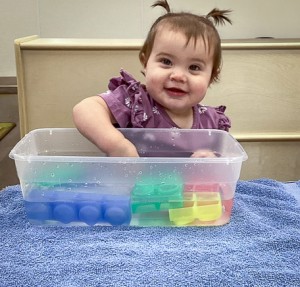
The Importance of Water Play in Early Childhood
It is summer and you know what that means? Water play and water fun! There have been studies by the Journal of Early Childhood Research that have shown a 32% improvement in a child’s problem-solving skills when they are engaged in water play. There are many other benefits to water play for your child. Including supporting their physical, cognitive, language, and social-emotional learning and development. At Children’s Lighthouse, we provide children with water play opportunities during our Sand & Water Learning Center in our Lighthouse CARES® classrooms, and water play is integrated into our Infant and Toddler curriculum activities and Lesson Plans.Colin’s Hope organization emphasizes the importance of water play safety. Explaining in their mission that “water safety, awareness, education, and resources are necessary to help prevent children from drowning.” According to the Centers for Disease Control and Prevention, drowning is the number 1 cause of death for children ages 1-4 and a leading cause for ages 1-14, explains Colin’s Hope. Therefore, it is important that we recognize both the importance of water play for our children’s development and water safety considerations to help ensure enjoyable experiences both at school and at home.
Water Play Fun
In the summer it is hot, and water play is a perfect way to cool off! Water play can be done at home in a variety of ways to support your child’s learning, growth, and development. Below are helpful activity ideas to support you at home:
Infants and Toddlers:
- In a small kiddie pool, fill it with about one inch of water and add some sponges, containers, or water toys. Watch your child enjoy splashing, pouring, squeezing, and playing in the water. Talk with them about their play using descriptive words.
- Using a dish bucket, add about 1 to 2 inches of water and blue color dye. Put plastic ocean animal water toys in the bucket. Use discussion while playing with your child, asking them questions about the animals, naming them, discussing the characteristics of them, and teaching them about the ocean.
Preschoolers:
- Sensory play: Provide tactile experiences for your child using a kiddie pool or water table. Allow them to explore in the sensation of water play, using discussions with your child to build vocabulary about wet and dry or the effects of the water temperature.
- Have children play in a water sprinkler. Set up a water sprinkler obstacle course for them in the yard, including a slip-and-slide.
School-Age:
- Allow them to explore with water play using the concepts of math! Provide them with water tools, or items, that can help them explore and teach concepts such as the water cycle, sink or float, density, volume, and measurements by pouring or filling containers of different shapes and sizes.
- Provide children with a large water bucket and PVC pipes of varied sizes. Encourage them to create a water flow system using the pipes into the bucket. This activity is great for STEAM learning, as it supports critical thinking skills, creative expression, and scientific concepts of trial and error for observing how water flows.
It is also important to ensure water play is safe at home with your child, or if you are experiencing water activities during the summer within your community. Below are considerations you can make to maximize water play safety for your child:
Water Safety Tips:
- Always visually supervise your children around water or in the water
- Teach your child how to swim or put them in swimming lessons. They offer these beginning at Infancy.
- Make sure all children wear a life jacket if they do water activities in large bodies of water.
- Check the water sources first if you are in the community or at a neighbor’s pool.
- Find places or parks in the community that have barriers around large bodies of water, to help minimize risks and allow for easier supervision of children.
- Keep your home and yard safe by monitoring water hazards and knowing the risks or dangers that may be a potential risk.
- Educate yourself on the risks and dangers of water play and find fun ways to engage with your children around water.
- Talk to your children about water safety.
The value of water play during the summer is priceless! At Children’s Lighthouse, we believe that exposing young children to water play through our sensory activities in the classroom helps develop thinking skills, creativity through exploration, and increases their physical development. Remember, providing your child with opportunities and experiences to play in the water, while keeping them safe, is an important part of the foundation during their early childhood years.



